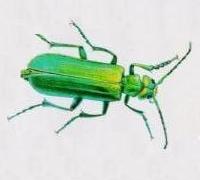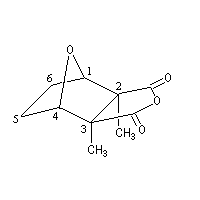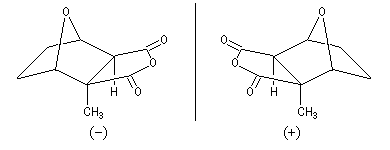Cantharidin : origin and synthesis
Gérard Dupuis & Nicole Berland
Lycée Faidherbe - LILLE
HTML version
What is cantharidin ?
The cantharidin was first isolated by Robiquet, a French chemist in 1810. It has an important role in the ecology of different kinds of insects that use or produce it as a defense ability to
preserve their eggs from predators [1]. In the ancient world, the dried spanish flies had the reputation of aphrodisiac virtues [27]. In fact,
these supposed properties are not attested neither in theory nor in experimentation. The cantharidin seems to be a dangerous substance with the same toxicity as the most violent poisonus like strychnin.
|

|
Two insect-families belonging to beetles produce this substance : the Meloidae and the Oedemeridae. The first family groups together thousands species in which the
Epicauta are the most widespread. Their most known representation is named Lytta Vesicatoria or Spanish fly [20].
The opposite photography represents an example of this insect.
|
The cantharidin molecule
At the usual temperature, the cantharidin is an odorless and colorless solid. Its formula is C10H12O4 and its melting point is 218 °C.
|

|
The cantharidin or 2, 3-dimethyl-7-oxabicyclo[2, 2, 1]heptane-2, 3-dicarboxylic anhydrid represented on the left picture, is an achiral compound. It has a plane
of symmetry that goes through the middles of the bonds C2C3 and C5C6. It's a meso compound (2S, 3R).
|
There is an other molecule with a similar structure : the palasonin. This molecule is produced by a tree butea frondosa that grows in the Himalaya. Contrary to the cantharidin, the palasonin is chiral and exists with two enantiomeric forms. The natural compound represented below is (-)-palasonin.
|
|

The two enantiomeric forms of the palasonin. Only the left exists in the nature.
|
Biosynthesis
Among the insects, the cantharidin is produced by the male and transfered to the female during the mating. The female will cover its eggs with this compound in a defense purpose. The complete mechanism of the biosynthesis is not known at the moment. But it is quite sure that it implicates reactions with as first compound a terpenic alcohol. A proof can be given with mass spectroscopy using the 14C, 3H, 18O isotopes [9].
|
|
The farnesol represented on the picture is the (E, E)-3, 7, 11-triméthyldodeca-2, 6, 10-triene-1-ol. This is a sesquiterpenic alcohol. It is an intermediate in the biosynthesis of isoprenoïds.

The farnesol is quite abundant in the nature. A lot of natural essences, like Ylang-ylang ones, contain this molecule.
|
The following diagram shows some cleavages and insertion of oxygen in a specific conformation of the farnesol that will lead to the cantharidin [20].

Mode of action of the cantharidin
The cantharidin inhibits the proteinphospatase 2A (PP2A), an enzyme that operates in the metabolism of glycogen [23].
First attemps for the synthesis of the cantharidin
Von Bruchhausen, a german chimist, first attempted the synthesis of the cantharidin [2]. It was based on the following retrosynthetic analysis.

Unfortunately, the Diels-Alder reaction between the two reactants deals to an equilibrium that is very unfavorable to the product. This fact is verified by the following experiment.
When the natural cantharidin is deshydrogenated, spontaneously it undergoes a retro Diels-Alder reaction.


A more deepened study shows that the instability of the product is due to the repulsion between the methyl groups carried by C2 and C3 and also to the repulsion between the hydrogen carried by C5 et C6 (the covering between the Van der Waals spheres is visible
with the "spacefill" representation of the molecular model of the cantharidin).
Synthesis of the cantharidin
The Stork synthesis
The first effective synthesis of the cantharidin was made in 1951 by the American chemist G. Stork (born in Belgium) [4] and [5]. The synthesis is completly linear and only uses classical reactions. It's a typical total synthesis of natural product dating from this period.

LiAlH4 permits the reduction of the ester functions. Thanks to the sulfonylation by the methanesulfonyl chloride of the alcoholic functions, the new substituant is a best leaving group than -OH and permits the nucleophilic substitution by a thiolate.

The dihydroxylation of the ethylenic bond is made by OsO4. The reduction of the thioether functions permits the introduction of the methyl groups. The action of HIO4 on the a-glycol permits to cut off the cycle and to create two aldehydic functions.

The creation of a cycle with five links is made by an aldol condensation following by the deshydratation of this aldol. The addition of PhLi permits to lead to an alcohol.



The Schenk synthesis
The Schenk's synthesis first uses a Diels-Alder reaction but here, the repulsions between the methyl groups don't exist and the equilibrium is favourable to the product [6].

Conjugated double bonds are made with the addition of Br2 on the ethylenic bond following by a double elimination with DBU.
DBU means 1,8-diazabicyclo[5.4.0]undec-7-ene. It's a bulky base that permits elimination.

The first key step of the synthesis is the cycloaddition [4+2] of the singlet oxygen.

The catalytic reduction by H2 of the peroxo bond (not very stable) leads to a-hydroxy-lactone.

The reaction with HBr permits to substitute the -OH group by an atom of Br.

The second key step is the opening of the lactone following by the formation of an oxo function with a rearrangement and the leaving of a bromide ion.

The -COBr function reacts with the acid function create a cyclic anhydrid.

The Dauben's synthesis
Dauben is an American chemist in Berkeley University. He uses high pressure to realize a lot of synthesis. The Diels-Alder's reaction is realizable
thanks to a pressure of 15 kbar. And then the synthesis of cantharidin necessitates only two steps [7], [8].


Bibliography
[1] Robiquet. M. Ann. Chim. 1810, 76, 302-307.
[2] von Bruchhausen, F.; Bersch, II. W. Arch. Pharm. Ber. Disch. Phurm. Ges. 1928, 266, 697-702.
[3] Diels. O.; Alder, K. Ber. 1929, 62, 554-562.
[4] Stork, G.; and al.J. Am. Chem. Soc. 1951, 73, 4501.
[5] Stork, G.; van Tamelen, E. E.; Friedman, L. I.; Burgstahler, A. W. J. Am. Chem. Soc. 1953, 75, 384.
[6] Schenck, G.; Wirtz, R. Naturwissenshaften 1953, 40, 531.
[7] Dauben, W. G.; Kessel, C. R.; Takemura, K. H. J. Am. Chem. Soc. 1980, 102, 6893-6894.
[8] Dauben, W. G.; Krabbenhoft, II. O. J. Am. Chem. Soc. 1976, 98, 1992-1993.
[9] McCormick, J. P.; Carrel, J. E.; Doom, J. P. J. Am. Chem. Soc. 1986, 108, 8071-8074.
[10] Sierra, J. R.; Woggon, W. D.; Schmid, H. Experientia 1976, 32, 142-144.
Links
[20] Ecology and Biosynthesis of Cantharidin and Palasonin
[21] O. Diels and K. Alder the Nobel Prize in Chemistry 1950
[22] Oxygen inorganic photochemistry
[23] Design and synthesis of selective phosphatase inhibitors
[24] Cantharidin : A Historical Overview and Synthetic Approach
[25] How does cantharidine work and what is it used for
[26] The British Pharmaceutical Codex, Cantharis B. P.
[27] Aphrodisiacs their biological basis
[28] Blister beetle intoxication
[HOME PAGE] [MOTM HOME PAGE]
For educational purpose - No commercial use
Page created by Gérard Dupuis - Lycée Faidherbe LILLE
gdupuis-prof@faidherbe.org
This site was last updated January 2004



















